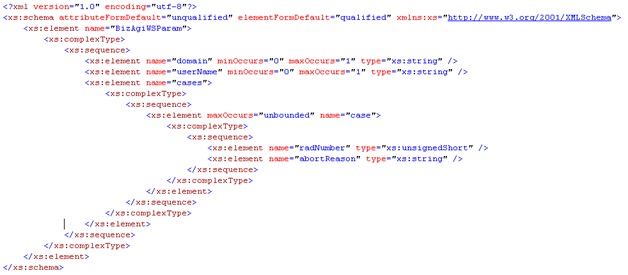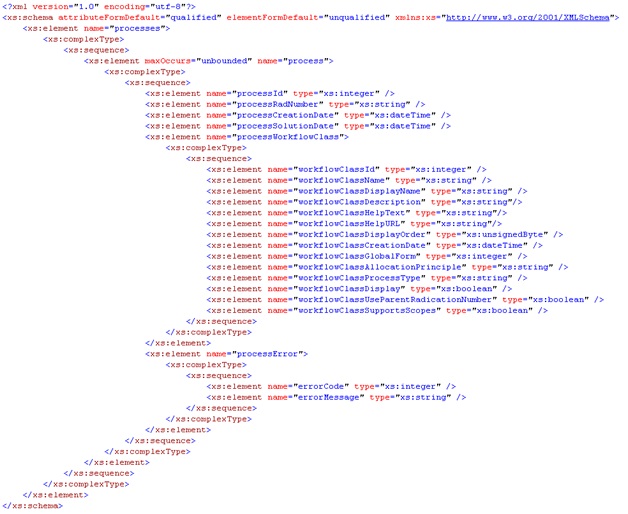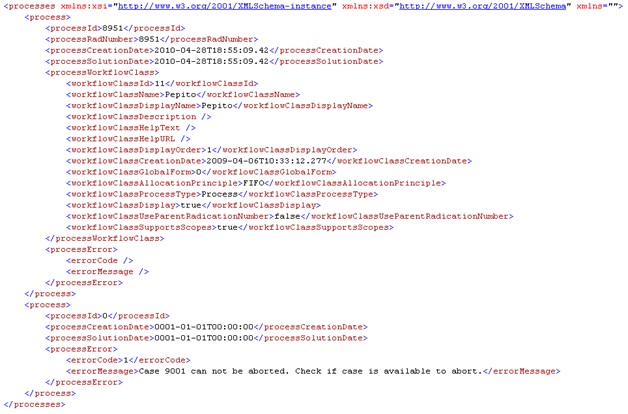AbortCases
From Business Process Management, BPM and Workflow Automation Wiki | BizAgi BPMS
<keywords content="keywords"> abortCases, abortcases, abortCasesAsString, abortcasesasstring, abort Cases, abort cases, SOA Layer, soa layer, WorkflowEngineSOA, workflowenginesoa, Workflow Engine SOA, workflow engine soa </keywords>
Contents |
abortCases
From the WorkflowEngineSOA web service, this method is used to abort or cancel one or more cases in Bizagi. This document also applies to the method abortCasesAsString.
Description
This method receives an XML indicating the creation number for the case and a reason for cancellation. For the abortCases method, the request and response XML's are of XmlDocument type, while in the abortCasesAsString method the same XML's are handled as string type.
Input Data
The expected XML must comply with this XSD schema (copy it from here):
Parameter 1 (XmlDocument or String Type)
BizAgiWSParam: Root node.
domain: Contains the domain name of the Bizagi user, which will be registered as the one who cancelled the case.
userName: Contains the name (used in Bizagi) of the user, which will be registered as the one who cancelled the case.
cases: This element is included to enclose several case elements depending on the number of cases being cancelled.
case: Here, the information of the case to be cancelled, is included.
radNumber: Refers to the creation number of the case.
abortReason: Write an explanation for aborting the case.
Example
With the following XML, two cases will be cancelled by the admon user (Bizagi’s default user).
Output Data
The returned XML must comply with this XSD schema (copy it from here):
The response includes basic information of the case (and process) just deleted. Here is the description of each data contained in the returned XML.
processes: Root node.
process: This element is included for each case that is to be cancelled.
processId: Identification number of the case (idCase).
processRadNumber: Alphanumeric value corresponding to the creation number of the case.
processCreationDate: Case creation date.
processSolutionDate: Case solution date.
processWorkflowClass: The information in this node is all about the process (process metadata) not about the particular case.
workflowClassId: Identification number (or key) of the process.
workflowClassName: Name of the process.
workflowClassDisplayName: Display name of the process.
workflowClassDescription: Process description.
workflowClassHelpText: Process help text.
workflowClassHelpURL: Help URL for the process.
workflowClassDisplayOrder: The order in which the process will be viewed in the web application.
workflowClassCreationDate: Creation date of the process.
workflowClassGlobalForm: Identification number of the process’s global form (zero if it is not configured).
workflowClassAllocationPrinciple: Reserved for future use.
workflowClassProcessType: Process type.
workflowClassDisplay: Indicates whether the process is visible or not.
workflowClassUseParentRadicationNumber: Indicates if a case of this process uses its own creation number or the same number as the parent process (if it is a subprocess).
workflowClassSupportScopes:
processError: If the process of cancelling a case is not successful, this element will contain information of the error.
errorCode: Code of the error that occurred, otherwise it will be empty.
errorMessage: Message of the error that occurred, otherwise it will be empty.
Example
Here is the XML in response to the one sent as an example:
In this example, it can be seen that for case number 8951, the cancel operation was executed successfully. However, for case 9001, which was previously aborted, the returned message explains that the case is no longer available to be aborted.
Go to SOA Layer <comments />




